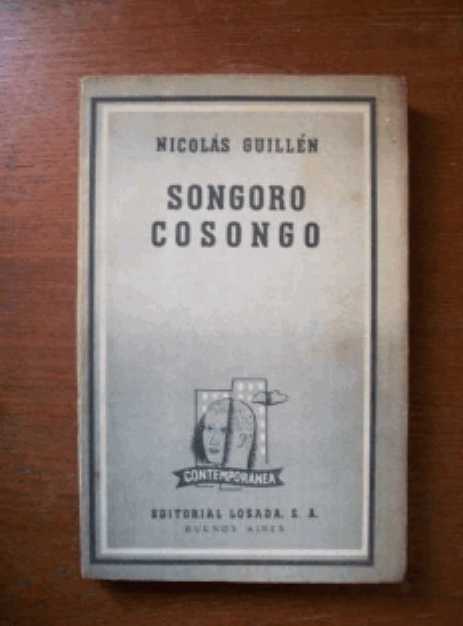4.1.1.14.2 “Sóngoro cosongo”, a collection of poems published by Nicolás Guillén in 1931

“Sóngoro cosongo”, a phrase repeated in the chorus of “Si tu saben…”, one of the poems in “Motivos de son”, whose final stanza oozes musicality (“!Sóngoro cosongo, / songo be;/ sóngoro cosongo/ of mamey; /sóngoro, the black woman / dances well;/ sóngoro of one,/ sóngoro of three./ Aé,/ come to be;/ aé / bamo pa be; / come, sóngoro cosongo, / sóngoro cosongo of mamey!”
In this collection of poems, he abandons some of the resources of his previous work, fundamentally the prosodic deformations, in order to cultivate a more universal lyricism that does not, however, abandon the preceding rhythmic discoveries but rather focuses on broader horizons from a cultural point of view.
The opening piece of the work contains the following verses:
“Here we are
The word comes to us wet from the forests,
and a strong sun dawns in our veins.
The fist is strong
and has the oar.
In the deep eye palm trees sleep
exorbitant.
The cry comes out of us like a drop of virgin gold.
Our foot,
hard and wide,
crushes the dust of abandoned roads
and narrow for our ranks.
We know where the waters are born,
and we love them because they pushed our
canoes under the red skies”
This is perhaps the most poetically elevated poem about the arrival of African slaves to Cuban lands—American in a broader sense—where the lyrical subject assumes a collective voice. However, some doubts arise as to whether these are truly slaves or aboriginals, given the tone of meekness not yet trampled by colonizing arrogance; however, perhaps Guillén deliberately fostered this ambiguity, to foreground only the vague arrival to our lands, multiple in its essence.
In some of these poems, a slower rhythm predominates, close to the magical-religious litany of ancestral origins, not associated solely with Black people. Throughout the collection, the emphasis is placed on mestizaje as a defining element of Cuban identity, over and above any direct allusion to its Black side, with an integrative sense of the people, where the poor Spanish emigrants of yesteryear converge.
One of the most transcendent poems in the text is “The Bongo Song,” which emphasizes racial and cultural integration around an instrument and, in a general sense, the convening magic of percussion. References to mestizaje, cultural syncretism, and everything that converged toward the unity embodied in music appear, lending a high aesthetic status to musical expressions from the Cuban slums:
“This is the bongo song:
-Here the one who is the finest,
answer if I call.
Some say; right now,
Others say: Here I go.
But my hoarse ringing,
but my deep voice,
summons the black and the white,
who dance the same tune,
brown-haired and brown-faced
more blood than sun,
because he who is not night on the outside,
It’s already dark inside
Here the one who is the finest,
answer, if I call…”
Many of the pieces express Cuban poverty, including the most desperate poverty of Black people. One of these is “Little Ode to a Black Cuban Boxer,” conceived as a tribute to Kid Chocolate, in which he denounces the social situation that forced him to engage in this “sport,” in those times of particular harshness and bloody spectacle. We can now see the face of the American puppeteer who controlled the country’s destiny.
This collection of poems draws on the aesthetic advances of “Motivos de son” and introduces other contributions to Cuban lyric poetry, including Americanist tones and a popular sense, along with a cultivation of form, while deepening the rhythmic conception and maintaining what might be called “gibberish” rhetoric, but with an impure Negrista influence. Guillén increasingly masters a myriad of rhetorical devices, but always geared toward popular reception, with which his poetry returns to the origins from which it was drawn with its distinctive poetic refinement.








